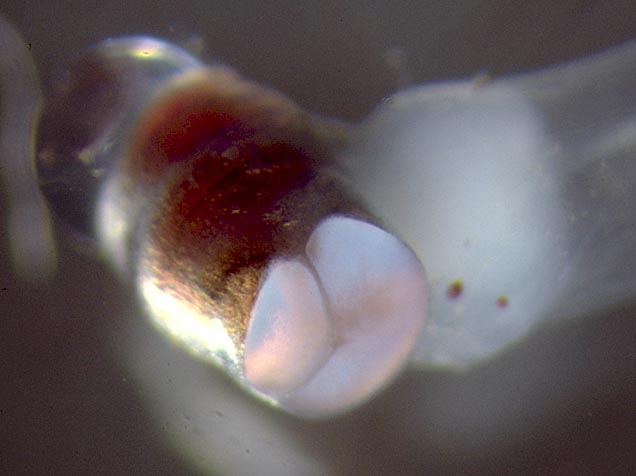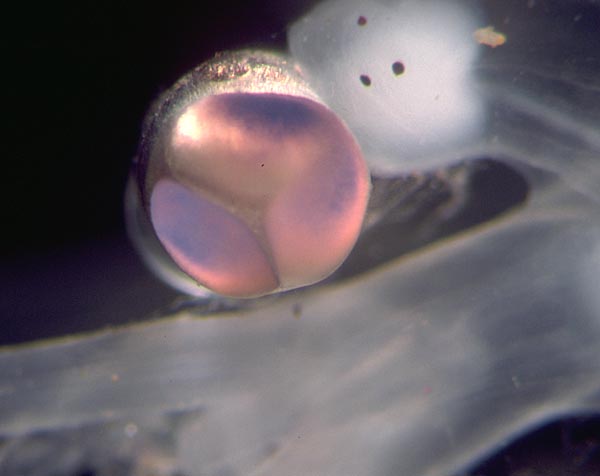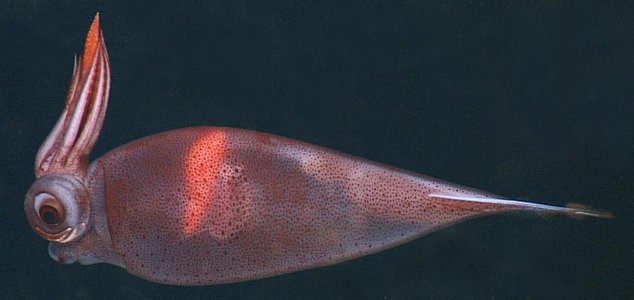Taonius
Richard E. Young and Katharina M. Mangold (1922-2003)- Taonius borealis (Nesis, 1972)
- Taonius pavo (Lesueur, 1821)
- Taonius belone (Chun, 1906)
Introduction
Species of Taonius are large squids (up to 660 mm ML) with long, slender terminal fins (as seen in the video still frame below) and hooklike teeth on largest club suckers. They are found circumglobally in the midwaters of the open ocean. An AVI/MPEG format video clip of this animal is available at Cephalopods in Action.
Brief diagnosis:
A taoniin ...
- with large, claw-like suckers in the medial two series on the club manus.
- with long, lanceolate, terminal fins.
Characteristics
- Tentacles
- Tentacular clubs with enlarged suckers that bear one or two large, central, hook-like teeth.*
- Distal 2/3 of tentacular stalk with two series of suckers and pads.
- Terminal pad on club with 2-3 suckers separated from dactylus suckers by narrow "neck."
- Head
- Eyes large, bulge from head, anteriorly oriented.
- Eyes large, bulge from head, anteriorly oriented.
- Funnel
- Funnel valve absent.
- Funnel organ: Dorsal pad with three round, fat papillae.
- Mantle
- Tubercles absent at funnel-mantle fusion (single tubercle may be present in young).
- Tubercles absent at funnel-mantle fusion (single tubercle may be present in young).
- Fins
- Terminal, lanceolate, very long and narrow; anterior insertion on gladius. However, the photograph below suggests that in T. borealis, at least, the anterior end of the fin attaches to the side of the mantle.
- Terminal, lanceolate, very long and narrow; anterior insertion on gladius. However, the photograph below suggests that in T. borealis, at least, the anterior end of the fin attaches to the side of the mantle.
- Photophores
- Two ocular photophores: Medial photophore large, crescent-shaped; lateral photophore small, crescent-shaped within concavity of first.
- Arm tip photophores absent.

Figure. Ventral view of the eye of a subadult T. pavo, 539 mm ML, showing photophores. Drawing from Voss (1980, p. 391, fig. 8d).
*Unique in family.
Comments
Characteristics are from Voss (1980).
Development of the hook-like teeth on the medial suckers of the manus is highly dependent of the size of the squid. In T. borealis the adult club is present at about 15 cm ML (Nesis, 1972).
Comparison of species
| Character / Species | T. pavo | T. borealis | T. belone |
| Largest club sucker: primary hooks | 2 | 1 | 1-2 |
| Largest club sucker: secondary hooks | 0 | 6-8 | 0 |
| Smaller enlarged medial manal suckers: secondary hooks | 0 | 6-8 | 4-5 |
| Large marginal manal sucker with two very enlarged, incurved distal teeth | No | No | Yes |
| Large marginal manal sucker laterally compressed | No | No | Yes |
| Carpal locking apparatus on club well defined | Yes | Yes | No |
Nomenclature
Contributed by Patrizia Jereb and Clyde RoperChun (1906) named Toxeuma belone from the Indian Ocean at 10°08'S, 97°14'E on the basis of a single specimen of 51 mm ML. Lane (1957) pointed out that the generic name Toxeuma was preoccupied and proposed the name Belonella belone. Nesis (1972) maintained a generic separation between Belonella and Taonius based in part on his observation of the different consistency of the tissues (gelatinous in Taonius and leathery in Belonella). Belonella and Taonius were synonymised by Voss (1980), even though some authors did not accept this action(e.g., Nesis, 1987, Okutani, 2005). The identity/validity of Chun's species, however, was long considered uncertain; ongoing research (Voss, pers. comm.), supporting previously published data (Nesis, 1987, Voss, 1988, Voss et al., 1992b) and working hypotheses (Young and Mangold, 2008), strongly indicate that T. belone should be synonymised with T. pacificus (the latter species name obtained by synonymising Belonella (pacifica pacifica, Nesis, 1972) with Taonius). Thus, the new combination is derived, Taonius belone (Chun, 1906), the specific name belone having priority.
Life history
As in Sandalops, species of Taonius go through a stage while in upper mesopelagic depths, in which the stalked eye has a nearly tubular shape (Young, 1975). The bottom of the eye is covered by two large photophores, one of which is strongly bilobed.



Figure. Ventral-oblique (left) and ventral (right) views of a tubular eye of a juvenile T. belone, off Hawaii. Photograph by R. Young.


Figure. Dorsal view of a young T. pavo (left) and a dorsal view of the anterior end of this squid (right), taken off Florida from a submersible of the Harbor Branch Oceanographic Institution. The eyes are just beginning the transition to a hemispherical shape. Large photophores appear to cover he posterior surface of the eyes. Photographs taken by E. Widder/HBOI.
References
Joubin, L. 1900. Céphalopodes provenant des Campagnes de la Princesse-Alice (1891-1897). Résult. Camp. Scient. Monaco, 17: 1-35.
Lane, F. W. 1957. Kingdom of the Octopus. The Life History of the Cephalopoda. Jarrolds. 287 pp.
Nesis, K. N. 1982/87. Abridged key to the cephalopod mollusks of the world's ocean. 385+ii pp. Light and Food Industry Publishing House, Moscow. (In Russian.). Translated into English by B. S. Levitov, ed. by L. A. Burgess (1987), Cephalopods of the world. T. F. H. Publications, Neptune City, NJ, 351pp.
Voss, N. A. 1980. A generic revision of the Cranchiidae (Cephalopoda; Oegopsida). Bull. Mar. Sci. 30: 365-412.
Voss N. A., S. J. Stephen and Zh. Dong 1992. Family Cranchiidae Prosch, 1849. Smithson. Contr. Zool., 513: 187-210.
Young, R. E. 1975. Transitory eye shapes and the vertical distribution of two midwater squids. Pac. Sci. 29: 243-255.
Title Illustrations

| Scientific Name | Taonius borealis |
|---|---|
| Location | Monterey Bay Canyon, Northeast Pacific at 36.5°N, 122.5°W; 1397 m depth.. |
| Comments | Image courtesy of the Monterey Bay Aquarium Research Institute (MBARI). You must obtain permission from MBARI to use this photo; please contact pressroom@mbari.org for further information |
| Acknowledgements | Susan Von Thun, photo editing, MBARI |
| Specimen Condition | Live Specimen |
| View | Side |
| Copyright | © 2011 MBARI |
About This Page
Drawings from Voss (1980) are printed with the Permission of the Bulletin of Marine Science.

University of Hawaii, Honolulu, HI, USA
Katharina M. Mangold (1922-2003)

Laboratoire Arago, Banyuls-Sur-Mer, France
Page copyright © 2016 and Katharina M. Mangold (1922-2003)
 Page: Tree of Life
Taonius .
Authored by
Richard E. Young and Katharina M. Mangold (1922-2003).
The TEXT of this page is licensed under the
Creative Commons Attribution-NonCommercial License - Version 3.0. Note that images and other media
featured on this page are each governed by their own license, and they may or may not be available
for reuse. Click on an image or a media link to access the media data window, which provides the
relevant licensing information. For the general terms and conditions of ToL material reuse and
redistribution, please see the Tree of Life Copyright
Policies.
Page: Tree of Life
Taonius .
Authored by
Richard E. Young and Katharina M. Mangold (1922-2003).
The TEXT of this page is licensed under the
Creative Commons Attribution-NonCommercial License - Version 3.0. Note that images and other media
featured on this page are each governed by their own license, and they may or may not be available
for reuse. Click on an image or a media link to access the media data window, which provides the
relevant licensing information. For the general terms and conditions of ToL material reuse and
redistribution, please see the Tree of Life Copyright
Policies.
- Content changed 22 November 2011
Citing this page:
Young, Richard E. and Katharina M. Mangold (1922-2003). 2011. Taonius . Version 22 November 2011 (under construction). http://tolweb.org/Taonius/19558/2011.11.22 in The Tree of Life Web Project, http://tolweb.org/












 Go to quick links
Go to quick search
Go to navigation for this section of the ToL site
Go to detailed links for the ToL site
Go to quick links
Go to quick search
Go to navigation for this section of the ToL site
Go to detailed links for the ToL site